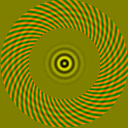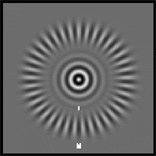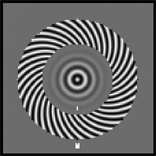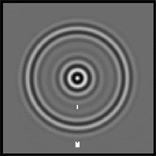 |
 |
During rivalry, transitions in dominance from one stimulus to the other can appear highly ordered. Rather than constituting an abrupt transition from one view to the other, one experiences waves of dominance whereby one stimulus sweeps the other out of conscious awareness. These waves of dominance are particularly prominent with larger rival patterns subtending several degrees of visual angle.
You can see these spreading waves for yourself using the rival targets pictured below. Start with the targets on the left (a spiral grating and a radial grating). Watch as the radial grating assumes dominance. Typically a small 'wedge' of the grating first breaks through suppression, and from there dominance expands over the entire annulus. Observers have characterized the pattern as resembling the traveling wave produced by a ring of dominoes that successively perturb one another. Compare this to the dynamics associated with the concentric grating in rivalry with the spiral figure (righthand rival targets). Here, too, one typically perceives a wave of dominance as the grating successively engulfs the spiral, but the transitions appear to occur more rapidly than with the radial grating.
 |
 |



The animations below simulate spatial waves produced by a simple neural model. Two layers of cortical neurons (L and R), one sensitive to each of the rivaling patterns, comprise the model. Via interneurons, each neuron in each layer inhibits a range of neurons in the other layer but does not inhibit neurons in its own layer. In the case of radial patterns rivaling with the spiral, these were the only network connections. To simulate collinear facilitation, weak reciprocal excitatory connections are included among neighboring neurons in the layer stimulated by the concentric pattern. To permit dominance alternations, the excitatory neurons in both layers (but not the inhibitory neurons) incorporate slow hyperpolarizing currents to produce spike rate adaptation.
In collaboration with Hugh Wilson and Sang-Hun Lee, I developed a procedure whereby waves of dominance can be triggered at a given region of a rival target and then "clocked" as the wave moves around the pattern. Details of the procedure are given here; the procedure and its consequence can be experienced using the anaglyphic animations provided below. For each demo, first position the cursor on "play" button on the controller at the bottom of the animation. Next fixate the central "bulls-eye" and monitor the on-going rivalry between the two rival figures in the annulus. Wait until the spiral pattern is completely dominant and then, while still fixating the center of the display, click the "play" button and watch the emerging pattern of dominance. Compare wave speed for the concentric figure (left-hand demo) and the radial figure (middle demo). Also notice what happens when the "wave" encounters a "gap" in the radial figure (right-hand demo).